![]()
![]()
![]()
Use LEFT and RIGHT arrow keys to navigate between flashcards;
Use UP and DOWN arrow keys to flip the card;
H to show hint;
A reads text to speech;
87 Cards in this Set
- Front
- Back
- 3rd side (hint)
|
Which of the properties of life involve metabolism? |
Energy Processing |
Order, Sensitivity or Response to Stimuli, Reproduction, Adaptation, Growth and Development, Regulation, Homeostasis, and Energy Processing |
|
|
Describe the process of homeostasis and give at least one example of it. |
ability to maintain a set range of internal conditions no matter the environment, thermoregulation - sweating, varying thickness of fur for bears, etc. |
"steady state" |
|
|
At what level does "life" emerge? |
Cellular Level |
Why viruses are not said to be living |
|
|
At what level does the reaction between living and non-living occur? |
Ecosystem |
Second to last |
|
|
At what level does multicellularity occur? |
Tissue |
Accumulation of cells |
|
|
What levels do not apply to single-celled organisms? |
Tissue, Organ, and Organ System |
Between CELLS and ORGANISMS |
|
|
What are the three domains? |
Eukarya, Archaea, and Bacteria |
One multi-cellular, two uni-cellular |
|
|
What are the two parts of the binomial naming system? How are they written? |
Genus (capitalized) and species (lower case) |
Homo sapiens |
|
|
What is the difference between a hypothesis and a theory? |
Hypothesis - suggestion that can be tested Theory - tested and confirmed |
"I think" and "I know" |
|
|
What is the order of the basic steps in scientific inquiry? |
Observation, Question, Hypothesis, Prediction, Experiment, Results, and Conclusions |
Make an... Frame a... Propose a... Make a... Conduct an... Assess the... Draw a... |
|
|
What are the properties that define life? |
Order, Sensitivity or Response to Stimuli, Reproduction, Adaptation, Growth and Development, Regulation, Homeostasis, and Energy Processing |
There are eight |
|
|
Name the Order in order. |
Atom, molecule, organelle, cell, tissue, organ, organ system, organism (population, community), ecosystem, and biosphere |
Atom to biosphere |
|
|
How many electrons can be in the first, second, and third shells? |
2, 8, 8 |
|
|
|
What is an isotope? What do they cause? |
Form of an element with different number of neutrons; radioactivity |
|
|
|
What is an ion? What do they cause? |
Unequal numbers of protons and electrons; has a net charge |
|
|
|
What is the significance of the term "organic"? |
Carbon and hydrogen must be involved |
|
|
|
Compare ionic and covalent bonds |
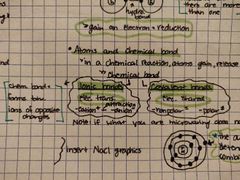
|
|
|
|
What are the five properties of water? |
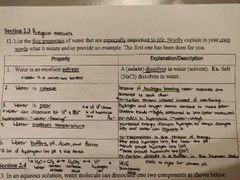
|
|
|
|
Why can some insects walk on water? |
Surface tension Some insects can walk on water, although they are heavier (denser) than water, because of the surface tension of water. Surface tension results from cohesion, or the attraction between water molecules at the surface of the body of water [the liquid-air (gas) interface]. |
|
|
|
What does water dissociate to? |

|
|
|
|
What can the pH tell you? Explain the numbers. |
Acidity/alkalinity 0.0-6.9 acidic 7.0-14.0 basic |
|
|
|
Explain how pH and the concentration of hydrogen ions relate. |
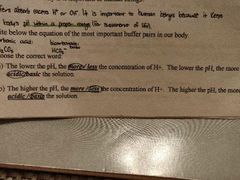
Less hydrogen ions = more hydroxide ions |
|
|
|
What do carbohydrates consist of? What is an example of each? |

|
|
|
|
Explain at least three functions that lipids serve in plants and/or animals. |
Fat serves as a valuable way for animals to store energy. It can also provide insulation. Phospholipids and steroids are important components of cell membranes. |
|
|
|
What are proteins made up of? |
Amino acids |
|
|
|
What is the purpose of nucleic acid? |
Continue life/carry generic blueprint for cell RNA - protein synthesis |
|
|
|
What are the three statements of the cell theory? |
1- all living things are composed of one or more cells 2- the cell is the basic unit of life 3- all new cells arise from existing cells |
Think the obvious |
|
|
When viewing a specimen through a light microscope, what do scientists use to distinguish the individual components of cells? |
Special stains (happen to kill living cells) |
|
|
|
What four structures do cells all have in common? |
Plasma membrane Cytoplasm DNA Ribosomes |
|
|
|
Where is DNA found in prokaryotic and eukaryotic cells? |
Pro- nucleoid Euk- nucleus |
|
|
|
What are the structures of the cytoskeleton? |
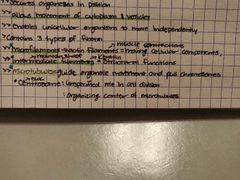
|
|
|
|
Why is cholesterol in the plasma membrane? |
Allows membrane to contract and expand |
|
|
|
What are the tails of the plasma membrane composed of? Hydrophobic or hydrophilic? |
Fatty acids; hydrophobic |
|
|
|
What is the difference between cytoplasm and cytosol? |
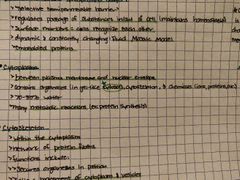
|
|
|
|
What are the four types of cellular junctions? Plant or animal? |
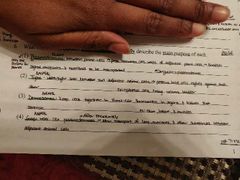
|
|
|
|
What structures do animals have that plants do not? |
Centrosomes Lysosomes Flagella Cilia Extracellular matrix |
|
|
|
What structures do plants have that animals do not? |
Cell wall Chloroplasts (contain chlorophyll) Central vacuole |
|
|
|
What are the differences between the rough endoplasmic reticulum and the smooth endoplasmic reticulum? |
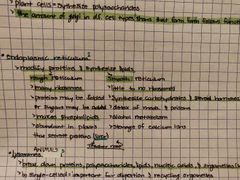
|
|
|
|
What are the two forms of passive transport? |
Simple diffusion and facilitated diffusion (transport protein required) |
|
|
|
Where does the cell get energy for active transport? |
The cell harvests energy from ATP produced by its own metabolism to power active transport processes, such as pumps. |
|
|
|
What affects the rate of diffusion? |
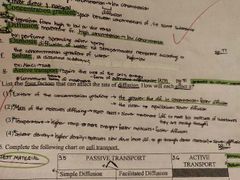
|
|
|
|
What is tonicity? |
The amount of a dissolved substance in a solution |
|
|
|
What are the three types of tonicity? |

|
|
|
|
What is a metabolic pathway? |
Series of enzyme-mediated stepwise chemical reactions |
|
|
|
Compare and contrast anabolic and catabolic pathways. |
Anabolic- small molecules into larger ones (energy required) Catabolic- large molecules into smaller ones (energy released) |
|
|
|
What is the equation for cellular respiration? |

|
|
|
|
Is photosynthesis and cellular respiration anabolic or catabolic? |
Photo- anabolic Cell Res- catabolic |
|
|
|
What is the 1st Law of Conservation? |
Total amount of energy in the universe is constant and conserved, transfered and transformed |
|
|
|
What is the 2nd Law of Conservation? |
Energy transfer/transformation is not 100% efficient, lost as heat energy = create entropy |
|
|
|
Define potential and kinetic energy. |
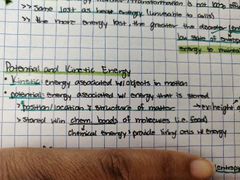
|
|
|
|
Which level has the highest amount of energy? (1st, 2nd, or 3rd shell) |
3rd, outermost |
|
|
|
Compare and contrast endergonic and exergonic. |
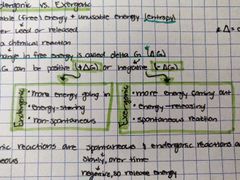
|
|
|
|
What enzyme is present in saliva? |
Amalase |
-LASE |
|
|
Explain how enzymes are regulated. Which enzyme helpers are used? |
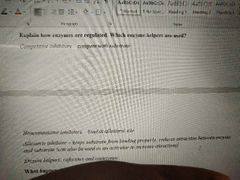
|
|
|
|
What happens in glycolysis? Where does it take place? |
6-carbon sugar molecule into two 3-carbon pyruvate molecules, cytoplasm |
|
|
|
What happens in the citric acid cycle? Where does it take place? |
Two 3-carbon pyruvate molecules into acetyl-CoA with help of enzyme helper coenzyme A (remove CO2), mitochondria |
|
|
|
How is the electrochemical gradient produced in oxidative phosphorylation balanced? |
Diffuse through ATP synthase protein |
|
|
|
How many ATP molecules are produced in the citric acid cycle? What is the total after oxidative phosphorylation? |
2, 36 |
|
|
|
What is chemiosmosis? |
Flow of hydrogen ions across membrane via ATP synthase |
|
|
|
Define heterotroph and autotroph. |
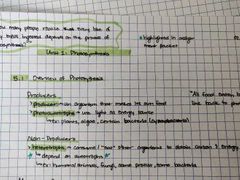
|
|
|
|
What is the equation for photosynthesis? |
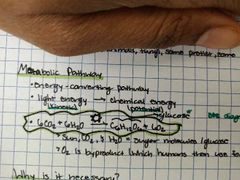
|
|
|
|
How does the byproduct of photosynthesis move up the food chain? |
Sugar is stored in carbohydrate molecules that are ingested and passed on from organism to organism |
|
|
|
What is the thylakoid, stroma, and granum? Where are these located? |
Thylakoid contain chlorophyll, stacks of thylakoids make up granums, and the stroma is the liquid around granums; ALL contained in chloroplasts |
|
|
|
What are the stages of photosynthesis? Where do they occur? |
Light-Dependent Reactions = thylakoid Calvin Cycle = stroma |
|
|
|
What stage of photosynthesis is similar to what stage of cellular respiration? |
Calvin cycle similar to Citric Acid cycle |
|
|
|
What is NADPH? |
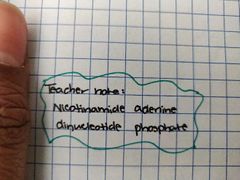
|
|
|
|
What are the stages of the Calvin cycle? What is the result of each? |
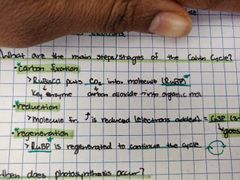
G3P goes on to make glucose and to regeneration |
|
|
|
Explain the connection between photosynthesis and cellular respiration. |
Photosynthesis takes the energy of sunlight and combines water and carbon dioxide to produce sugar and oxygen as a waste product. The reactions of respiration take sugar and consume oxygen to break it down into carbon dioxide and water, releasing energy. Thus, the reactants of photosynthesis are the products of respiration, and vice versa. |
|
|
|
Compare and contrast a human somatic cell to a human gamete cell. |

|
|
|
|
What is the 23rd pair of chromosomes referred to as? Why are they not considered homologous? |
Sex chromosome; males contain both X and Y chromosomes |
|
|
|
How are chromosomes numbered in karyotypes? |
By size, from largest to smallest |
|
|
|
What are the three stages of interphase? What happens in each? |
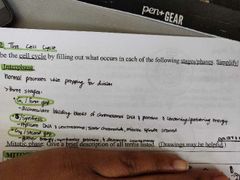
|
|
|
|
What are the five stages of mitosis? Name in order of occurrence. |

|
|
|
|
What stage of mitosis features the separation of sister chromatids? |
Anaphase |
|
|
|
What stage of mitosis features the ability to see chromosomes? |
Prophase |
|
|
|
At what portion of the cell cycle are chromosomes duplicated? |
S phase of Interphase |
|
|
|
Compare and contrast cytokinesis of animals and of plants. |

|
|
|
|
What are the three cell cycle checkpoints? What do they check for? |
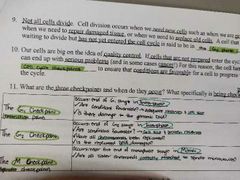
|
|
|
|
Compare and contrast proto-oncogenes and tumor suppressors. |
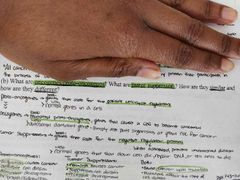
|
|
|
|
What process do prokaryotic cells employ for cell division? |
Binary fission |
|
|
|
What eukaryotic cell cycle event is missing in the prokaryotic cell cycle? |
Mitosis |
|
|
|
What is the difference between mitosis and meiosis?
|
Meiosis- special type of mitosis that occurs only in gamete/sex cells, not identical Mitosis has one cell division and meiosis has two |
|
|
|
Compare and contrast inductive and deductive reasoning. |
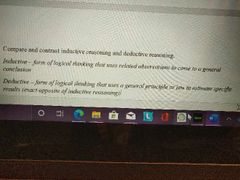
|
|
|
|
What elements make up the key building blocks of the chemicals found in living things? |
Carbon, hydrogen, nitrogen, oxygen, sulfur, and phosphorus |
|
|
|
What is the proper pH of blood for the human body? |
7.35-7.45 |
|
|
|
What are the four major biological macromolecules? |
Carbohydrates, lipids, proteins, and nucleic acids |
|
|
|
Contrast the three forms of microscopes. |
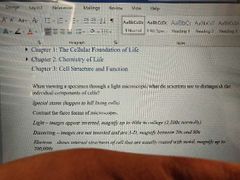
|
|

